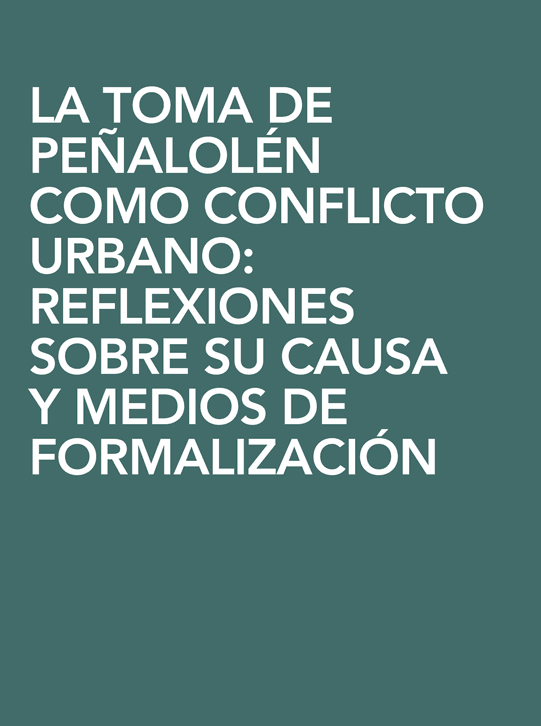La toma de Peñalolén como conflicto urbano: reflexiones sobre su causa y medios de formalización
Barra lateral del artículo

Palabras clave:
Contenido principal del artículo
Resumen
Este artículo explora el sentido que adquiere el “conflicto urbano” desde la perspectiva de un asentamiento de auto ayuda. Se asume que los conflictos, al igual que los asentamientos, son multi-dimensionales y multi-escalares. En vez de perpetuar una noción de los asentamientos como un “conflicto” que padecen ciertos lugares del mundo (sur global), apostamos por entenderlos como una expresión de diversidad, aportando a imaginar y construir una parte alternativa de la ciudad (Robinson, 2006). Destacaremos tres dimensiones: gobernanza (Swyngedouw, 2011), sentido de lugar (Harvey 2001), y planificación (Roy, 2005; Friedmann, 2005). Algunas de las conclusiones sugieren replantear la planificación que niega la existencia de conflictos e intenta “solucionar” el problema de los asentamientos por cualquier medio. Los asentamientos también influyen en la forma que se coopera, prioriza y se obtiene consenso para gobernar la ciudad. Finalmente, los lugares afectan la naturaleza del conflicto y su solución. Consideraremos como caso de estudio la Toma de Peñalolén, localizada en el sector oriente de Santiago de Chile. Se exponen resultados de una investigación reciente basada en 35 entrevistas, una encuesta y fuentes secundarias.
Detalles del artículo

Esta obra está bajo una licencia internacional Creative Commons Atribución-NoComercial 4.0.
Materia Arquitectura proporciona acceso inmediato y gratuito a todos los contenidos de esta edición electrónica, publicada simultáneamente con la edición impresa. Materia Arquitectura no cobra honorarios a los autores por ningún concepto.
Todos los contenidos de esta edición electrónica se distribuyen bajo licencia Creative Commons de “Atribución-Copartirigual 4.0 Internacional” (CC-BY-SA).
La licencia Creative Commons permite el acceso libre e inmediato al contenido y permite que cualquier usuario lea, descargue, copie, distribuya, imprima, busque o genere enlaces a los textos completos de los artículos, permitiendo también que estos puedan ser rastreados para indexarlos, pasarlos como datos a software o usarlos para cualquier otro propósito legal. Asimismo, la licencia otorga derechos de uso a quienes a su vez utilicen una licencia abierta (Creative Commons o equivalente).
Los derechos de los textos y las imágenes publicadas pertenecen a sus autores, quienes otorgan a Materia Arquitectura la licencia para su uso. La gestión de los permisos y la autorización de publicación de las imágenes (o de cualquier material) que contenga derechos de autor y sus consecuentes derechos de reproducción en esta publicación es de exclusiva responsabilidad de los autores de los artículos.
Toda vez que mencionen su origen, los autores son libres de distribuir sus artículos por otros medios. Cualquier reproducción total o parcial del material deberá citar su procedencia.
Descargas
Citas
ELGERT, L., & KRUEGER, R. (2012). Modernising sustainable development? Standardisation, evidence and experts in local indicators. Local Environment, 17(5), 561-571.
FRIEDMANN, J. (2005). Globalization and the emerging culture of planning. Progress in Planning, 64, 183-234.
FRÖSÉN, K. (2013). NGOs and Governmentality in Chile. The Case of TECHO and slum eradication programs. Obtenido de Lund University Libraries, LUP Student Papers: http://lup.lub.lu.se/student-papers/record/4003310
GIANNOTTI, E. (2014). Orígenes de un diseño participativo: la construcción de los barrios populares de Santiago. 1952-1973. Revista 180(34), 22-29.
GONZÁLEZ, C. (18 de mayo de 2015). Estudio muestra cómo ha cambiado el mapa social de Santiago. Recuperado el 10 de septiembre de 2015, de Diario La Tercera:
http://www.latercera.com/noticia/tendencias/2015/05/659-630172-9-estudio-muestra-como-ha-cambiado-el-mapa-social-de-santiago.shtml
HARVEY, D. (1996). Justice, Nature and the Geography of Difference. Cambridge, EE.UU.: Blackwell.
HARVEY, D. (2001). Spaces of Capital: Towards a Critical Geography. Nueva York, EE.UU.: Routledge.
LAGOS, R. (1999). Caminos de la igualdad. Tarjetón del candidato Ricardo Lagos para las elecciones presidenciales. Recuperado el 16 de septiembre de 2015, de Archivo Electoral:
http://www.archivoelectoral.org/imagenes/caminos-de-la-igualdad/679
LAPEYRE, F. (2013). Securing Livelihoods in Africa: Towards Multi-Scalar Policy Frameworks. European Journal of Development Research, 25(5), 659-679.
LEFEBVRE, H. (1996). The right to the city. En H. Lefebvre, E. Kofman (Ed.), & E. Lebas (Ed.), Writings on cities (págs. 147-159). Cambridge, EE.UU.: Wiley-Blackwell.
LUGO, M. A. (2005). Comparing Multidimensional Indices of Inequality: Methods and Application. Recuperado el 12 de septiembre de 2015, de Society for the Study of Economic Inequality: www.ecineq.org/milano/wp/ecineq2005-14.pdf
OCDE. (2013). Territorial Reviews: Antofagasta, Chile. París, Francia: OECD Publishing.
OZLER, I. (2012). The Concertación and Homelessness in Chile. Market-based Housing Policies and Limited Popular Participation. Latin American Perspectives, 39(4), 53-70.
PNUD. (1999). Índice de desarrollo humano en Chile 1990-1998. Número 3. Recuperado el 16 de septiembre de 2015, de Desarrollo Humano en Chile (PNUD):
http://desarrollohumano.cl/idh/download/todo.pdf
ROBINSON, J. (2006). Ordinary Cities: Between Modernity and Development. Londres, Inglaterra: Routledge.
Artículos más leídos del mismo autor/a
- Juan Pablo Astorga del Río, Self-help settlements as insights to urban conflicts: the case of Toma de Peñalolén in Santiago, Chile , Materia Arquitectura: Núm. 12 (2015): Materia Arquitectura 12 (Diciembre/December 2015)